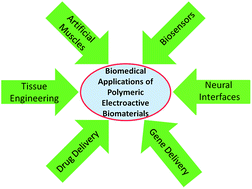Electrically conductive polymers and composites for biomedical applications
Abstract
Electrically conductive polymeric materials have recently attracted considerable interest from academic and industrial researchers to explore their potential in biomedical applications such as in biosensors, drug delivery systems, biomedical implants and tissue engineering. Conventional conductive homopolymers such as polypyrrole and PEDOT show promising conductivity for these applications, however their mechanical properties, biocompatibility and processability are often poor. This has led to more recent attention being directed towards conductive polymeric composites comprised of biostable/biocompatible polymers with dispersed conductive fillers such as graphene, carbon nanotubes and metallic nanoparticles. The major objective of this paper is to provide an up to date review of the recent investigations conducted in the development of conductive polymer composites focussing on the methods of their preparation, underlying concepts of their conductivity and the ways to tailor their properties. Furthermore, recent progress made in conventional conducting polymers and their composites/blends for biomedical applications is also discussed.

- This article is part of the themed collections: Conducting polymers and Sensors for health and happiness


 Please wait while we load your content...
Please wait while we load your content...